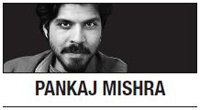 A new narrative about India is suddenly emerging. Until very recently, India appeared to be a great democracy as well as a rising economic power, a potential partner of the West in its policy of containing China. Writing in Time magazine in 2015, no less a moral and political authority than Barack Obama hailed Prime Minister Narendra Modi as India’s “reformer-in-chief” who “reflects the dynamism and potential of India’s rise.”
A new narrative about India is suddenly emerging. Until very recently, India appeared to be a great democracy as well as a rising economic power, a potential partner of the West in its policy of containing China. Writing in Time magazine in 2015, no less a moral and political authority than Barack Obama hailed Prime Minister Narendra Modi as India’s “reformer-in-chief” who “reflects the dynamism and potential of India’s rise.”However, the latest, radically different narrative about India holds that the country is flailing, its politics and civil society captured by a Hindu supremacist movement, and its economy trapped in a potentially long slowdown.
Evidence that India’s prime minister is not the smart economic modernizer he seemed to many in the West has become steadily incontrovertible, especially after he quixotically withdrew most currency notes in circulation in 2016.
This week, an exhaustively researched report in the New Yorker by Dexter Filkins provided spine-chilling evidence that India is ruled by cold-blooded ideological fanatics, who will use all means to achieve their aims. These can range from perversion of the media, judiciary and military to anti-Muslim pogroms, targeted assassinations of critics and collective punishment of a minority.
Such a dramatic reversal of reputations -- “from hero to zero,” as the Indian wisecrack goes -- is not new in India’s case. For much of India’s seven decades, when it appeared to be on the wrong side of the Cold War, Western commentators regarded the country as a basket case.
As Thomas Friedman put it in “The World is Flat: A Brief History of the Twenty-First Century,” India was “known as a country of snake charmers, poor people, and Mother Teresa” before it was abruptly rebranded, including by Friedman, as a “country of brainy people and computer wizards.”
As India embraced market capitalism, moved away from its Russian friends and came closer to the West, every major Western periodical, from the Economist and Foreign Affairs to the Financial Times and the Wall Street Journal, started to broadcast the myth of an irresistibly “rising” India.
As India suffers another downgrade in global reputation, it is worth asking: How do fundamentally defective narratives acquire outsize influence? And, is the new narrative about India as simplistic and misleading as the old?
Certainly, it has long been clear that India, which failed to invest in primary education and health, did not have the human capital and infrastructure necessary for what it urgently needed: a labor-intensive manufacturing revolution of the kind that made such “East Asian Tigers” as South Korea and Taiwan.
Economic growth in India was built on such shaky foundations as speculative finance capital and construction, and never seemed strong and consistent enough to generate jobs for the approximately million people entering the workforce each month.
Nor was India robust enough to contribute effectively to the Western coalition against China. India humiliatingly lost a border war in 1962 and several subsequent diplomatic-military scuffles. It has not even come close to matching its neighbor’s economic performance.
But commentators were too bedazzled by such notions as (John McCain’s) “league of democracies” and too influenced in their thinking by a Cold War division of the world into blocs and counterblocs.
Many Indians living or educated in the West were seduced by the idea that their country, which once mortifyingly denoted elephants, Maharajahs and beggars to the average Westerner, was assuming its place among the elite nations.
As for those in the knowledge industry (academics, journalists, columnists, think-tankers), it is always tempting to set aside intellectual hesitations and moral scruples and stand with history’s seeming winners.
It will be no less tempting to recoil from its supposed losers. Indeed, as multiple crises rock India, from crippling bank debts to lynch mobs, many of its previous promoters repackage themselves as outspoken critics of Modi.
These unreliable narrators of India should not make us forget, however, that long before Modi came to power in 2014, the country’s economy had already developed its unhealthy dependence on finance, corruption and inequality were intolerable, and politicians accused of anti-minority pogroms revolved serenely through the corridors of power.
Torture and extrajudicial execution have been commonplace for decades, especially in Kashmir and insurgency-affected central India. In 2013, the Supreme Court sent a Kashmiri to the gallows on flimsy circumstantial evidence, arguing that “the collective conscience of the society will only be satisfied if the capital punishment is awarded to the offender.”
To India’s hollowed-out institutions, Modi has delivered a lusty kick; they have predictably collapsed into a heap. But the dust that rises from them should not again cloud our optics.
Modi is a symptom rather than the main cause of the country’s political degeneration and economic stagnation. Until this is acknowledged, it won’t be possible to correctly diagnose, let alone stem, India’s deepening rot.
By Pankaj Mishra
Pankaj Mishra is a Bloomberg Opinion columnist. -- Ed.
(Bloomberg)
-
Articles by Korea Herald











![[Today’s K-pop] BTS pop-up event to come to Seoul](http://res.heraldm.com/phpwas/restmb_idxmake.php?idx=644&simg=/content/image/2024/04/17/20240417050734_0.jpg&u=)





![[KH Explains] Hyundai's full hybrid edge to pay off amid slow transition to pure EVs](http://res.heraldm.com/phpwas/restmb_idxmake.php?idx=652&simg=/content/image/2024/04/18/20240418050645_0.jpg&u=20240418181020)

![[Today’s K-pop] Zico drops snippet of collaboration with Jennie](http://res.heraldm.com/phpwas/restmb_idxmake.php?idx=642&simg=/content/image/2024/04/18/20240418050702_0.jpg&u=)